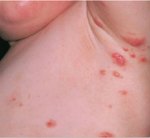 >Scabies is a well-known infection that results in a particularly relentless and devastating itch that starts out slowly and increases in severity over time. The mites that cause the condition, scientifically known as Sarcoptes scabiei, burrow into the skin of infected humans. While they are so tiny that it’s not possible to see them with the naked eye, they can be appreciated by examination with a magnifying glass or microscope.
>Scabies is a well-known infection that results in a particularly relentless and devastating itch that starts out slowly and increases in severity over time. The mites that cause the condition, scientifically known as Sarcoptes scabiei, burrow into the skin of infected humans. While they are so tiny that it’s not possible to see them with the naked eye, they can be appreciated by examination with a magnifying glass or microscope.
>Sometimes, doctors or others health-care providers may refer to “Norwegian” scabies, and this term can be confusing. The name seems to imply that the condition is caused by a specific type of mite that is found in Norway or that preferentially affects people of Norwegian descent, neither of which is true. The term “Norwegian scabies” refers instead to a particularly severe form of scabies that is also known as crusted scabies. Crusted scabies has been called Norwegian scabies because the condition was first described in Norway in the mid-19th century.
>Garden-variety scabies produces small bumps and blisters in the webs between the fingers, on the wrists, the backs of the elbows, in the groin, on the knees, and on the buttocks. Men sometimes get what look like pimples on their penis. The infection is transmitted by any close contact, including sexual contact, so scabies is considered to be one of the sexually transmitted diseases. In otherwise healthy people, not every bump on the skin is a bug. In fact, in most cases of scabies in healthy adults, there are no more than 10 or 15 live mites on the skin even if the infected person has hundreds of bumps and pimples.
>Norwegian scabies, or crusted scabies, is different. There seems to be a problem with the immune response to the mites, allowing for the infestation of an individual with hundreds of thousands of the mites. Crusted scabies almost always affects people with a compromised immune system and is observed most frequently in the elderly, those who are mentally or physically disabled, and in patients with AIDS, lymphoma, or other conditions that decrease the effectiveness of the immune response. The lesions of this distinctive form of scabies are extensive and may spread all over the body. The elbows, knees, palms, scalp, and soles of the feet are most commonly the original sites of involvement, and the scaly areas eventually take on a wart-like appearance. The fingernails can be thickened and discolored. Interestingly, itching may be minimal or absent in this form of scabies.
>A particular danger of crusted scabies is that these lesions often predispose to the development of secondary infections, as with Staphylococcus bacteria. Like typical scabies, Norwegian scabies is treated with topical permethrin cream (Elimite) and the oral medication ivermectin (Stromectol). While classical scabies is usually treated with one of the above, treatment of crusted scabies can require oral medications along with multiple applications of a scabicide cream.
http://www.medicinenet.com/script/main/art.asp?articlekey=86345








